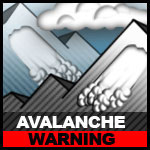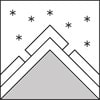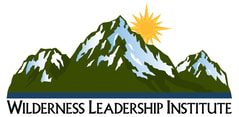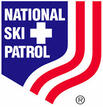
Avalanche Danger Warning
Travel in Avalanche Terrain is Not Advised
Travel in Avalanche Terrain is Not Advised
Snowpack Summary March 21, 2023
Posted by Allen Giernet @ 6:30 am (this summary expires in 24 hours)
This summary applies to backcountry areas only.
The Bottom Line –
Another large storm with much lower snow lines has moved in. Wind slab avalanches will be developing and will grow in potential size and sensitivity today. Storm Slab avalanches will become a problem with significant precipitation rates forecast through the day. Over 40” of new snow is forecast for today near 8,000’. Travel in, near or below avalanche terrain is not advised.
Please share your observations with us at the avalanche center Submit Reports page.
Posted by Allen Giernet @ 6:30 am (this summary expires in 24 hours)
This summary applies to backcountry areas only.
The Bottom Line –
Another large storm with much lower snow lines has moved in. Wind slab avalanches will be developing and will grow in potential size and sensitivity today. Storm Slab avalanches will become a problem with significant precipitation rates forecast through the day. Over 40” of new snow is forecast for today near 8,000’. Travel in, near or below avalanche terrain is not advised.
Please share your observations with us at the avalanche center Submit Reports page.

Wind Slab avalanches are the release of a cohesive layer of snow (a slab) formed by the wind. Wind typically transports snow from the upwind sides of terrain features and deposits snow on the downwind side. Wind slabs are often smooth and rounded and sometimes sound hollow, and can range from soft to hard. Wind slabs that form over a persistent weak layer (surface hoar, depth hoar, or near-surface facets) may be termed Persistent Slabs or may develop into Persistent Slabs.

Storm Slab avalanches are the release of a cohesive layer (a slab) of new snow that breaks within new snow or on the old snow surface. Storm-slabs typically last between a few hours and few days (following snowfall). Storm-slabs that form over a persistent weak layer (surface hoar, depth hoar, or near-surface facets) may be termed Persistent Slabs or may develop into Persistent Slabs.
General Summary
#1 Wind Slab – Will have begun to develop overnight with several inches of snow already reported and strong Southwest winds. They will be likely on Northeast to North to Northwest aspects but could be possible on all aspects due to topographic influence. Look for signs of wind slabs below ridges and along gullies on leeward slopes. Watch for signs of transported snow, scouring, pillowing and wind textured snow to indicate windslab development. Wind Slabs will grow in size and sensitivity through the day with heavy snowfall and strong winds forecast.
#2 Storm Slab – Storm Slabs will begin to develop today growing quickly in potential size and likelihood. Extremely high snowfall rates are forecast today and tomorrow with over 40” forecast for the 24 hour period beginning around midnight last night and another 24” for tomorrow. This will be more likely at higher elevations but possible at all elevations and aspects.
This storm over the next 48 hours is forecast for 60” or more of snow total and near 7” of water equivalent. This will add significant load to the snowpack. At the present time access has been very limited into the mountains and actual snowpack structure understanding is very low. With the significant rain event up to high elevation during the previous storm, the probability is any weak layers in the upper snowpack would have been effected by water and refrozen. This has not been confirmed and serious uncertainty remains. We can not rule out any persistent grain problem in the snowpack, and with such a significant load being added extra caution in watching for signs of instability and decision making would be highly recommended. During and immediately following this storm travel into, near or below avalanche terrain is not advised.
Exercise caution if venturing out into the mountains and use avalanche protocols, travel with a partner and bring your beacon, shovel and probe.
Please share any information when you are out in the mountains. Even a photo is helpful. Submit observations to Submit Reports page.
#1 Wind Slab – Will have begun to develop overnight with several inches of snow already reported and strong Southwest winds. They will be likely on Northeast to North to Northwest aspects but could be possible on all aspects due to topographic influence. Look for signs of wind slabs below ridges and along gullies on leeward slopes. Watch for signs of transported snow, scouring, pillowing and wind textured snow to indicate windslab development. Wind Slabs will grow in size and sensitivity through the day with heavy snowfall and strong winds forecast.
#2 Storm Slab – Storm Slabs will begin to develop today growing quickly in potential size and likelihood. Extremely high snowfall rates are forecast today and tomorrow with over 40” forecast for the 24 hour period beginning around midnight last night and another 24” for tomorrow. This will be more likely at higher elevations but possible at all elevations and aspects.
This storm over the next 48 hours is forecast for 60” or more of snow total and near 7” of water equivalent. This will add significant load to the snowpack. At the present time access has been very limited into the mountains and actual snowpack structure understanding is very low. With the significant rain event up to high elevation during the previous storm, the probability is any weak layers in the upper snowpack would have been effected by water and refrozen. This has not been confirmed and serious uncertainty remains. We can not rule out any persistent grain problem in the snowpack, and with such a significant load being added extra caution in watching for signs of instability and decision making would be highly recommended. During and immediately following this storm travel into, near or below avalanche terrain is not advised.
Exercise caution if venturing out into the mountains and use avalanche protocols, travel with a partner and bring your beacon, shovel and probe.
Please share any information when you are out in the mountains. Even a photo is helpful. Submit observations to Submit Reports page.
General Mountain Weather Forecast |
Weather Page Link
Click on the links below for the latest information
Click here for this Season's Snow Pack Summaries
To better understand the challenges and potential variability over the large area we are producing information for please read our Snowpack Summary - Format and Limitations
Disclaimer:
This Bulletin is designed to generally describe conditions where local variations always occur. Travelers are advised to exercise caution and make slope specific evaluations. As always, please treat this bulletin with appropriately guarded skepticism and make your own assessments. Help to provide more information to the community by reporting your observations
This Bulletin is designed to generally describe conditions where local variations always occur. Travelers are advised to exercise caution and make slope specific evaluations. As always, please treat this bulletin with appropriately guarded skepticism and make your own assessments. Help to provide more information to the community by reporting your observations
Latest Observtions
Click on the observation to go to the full report
|
Observation type
Avalanche Location - Mt. Baden Powell Date (yyyymmdd) - Comment - This avalanche was observed from Mtn High on the northeastern face of Baden Powell. There’s much less snow since last weekend before the big rain event. |
Observation type
Avalanche Location - Grinnel Mountain SB Date (yyyymmdd) -20230318 Comment We observed a skier trigger R1-D1 loose avalanche at about 9500' on N aspect below tree-line, and an older natural R1-D2 avalanche on the N aspect at about 9250'. We were descending from Grinnell Mountain in the San Gorgonio area. The skier triggered R1-D1 may have been powerful enough to knock skier off their feet, but not big or powerful enough to bury anyone. It was caused when skiing through unconsolidated heavy snow on shaded/colder N aspect on a slope approx. 36 degrees. Loose debris ran for approx. 100 feet before coming to a stop. Skiers were well out of harms way in a safe zone. Further down the descent, at approx. 9250' on N aspect we observed a natural avalanche that had occurred a few days prior. We did not see an obvious crown. Perhaps a loose point release stepped down into a crust? The debris visible do seem bonded in small blocks, indicating more structure in the snow than just a loose point release. |
Observation type
Avalanche Location - Baldy Bowl Date (yyyymmdd) - 20230317 Comment - Lots of loose-wet debris in the Baldy bowl, likely from rain on snow from the warm storm this week. Shooting cracks observed near the Baldy-Harwood Saddle and Devils Backbone west of Register Ridge. |
Observation type -
Snowpack Location - Mt. San Antonio Date (yyyymmdd) - 20230309 Comment - We left Manker Flat area at 5:15am and reached the top of Mt. San Antonio (Baldy) at about 10:30am. We ascended mostly via crampons as the snow was still a bit too iced for skinning. No recent avalanches were observed on the S face of "Baldy Bowl" during our ascent on S face. No cracking, woomfing, or hollowness was observed during our ascent on S face. At the top of Mt. San Antonio, we observed moderate to strong winds. Although no snow was being actively transported during our observation, we witnessed heavily wind affected snow at the top of the ridge and peak. Some wind loading was observed on some aspects at the peak elevation, but our main concern was ice. Blue ice was observed on the ridge around the peak. Some avalanche activity was observed on distant extreme terrain on NE aspects off Telegraph and Ontario Peak. We descended down the NW face of Mt. San Antonio. We avoided the wind loaded leeward slopes, opting instead for barely edgeable ice crust for the first 100 feet or so. This ice eventually yielded to soft wind effected snow. We eventually came to the crux 3/4 of the way down and opted to down climb with crampons and axes. We did observe one small area R1? of snapped trees (but no other debries, indicating an older avalanche) on an E facing aspect below treeline. After completing descent, we climbed up the R ridge, gaining the col between San Antonio and Harwood and skied down the S face of San Antonio. No wet slide activity was observed on our descent down the S face. These observations occurred before a rain/snow event on March 10th and 11th. |
General Caution
You should always use safe terrain management and carry avalanche rescue equipment in the backcountry. Most avalanches are triggered by someone in the party or the victim. Practice with your rescue gear often and be prepared should the worst happen. Though we do not have an avalanche forecast center in this area as of yet, the information posted and shared here as well as the resources available on this site will help to make informed decisions for your backcountry travels. Use avalanche forecasts in your travels wherever available and be aware that avalanche ratings are general information. Elevation, location, geographic variability’s, slope aspect and angle all have effects on the particular area you travel in. This is only one piece of the information you should use in your decision making process. There is no substitute for avalanche education, for more resources and information as well as education please refer to our resources page.
You should always use safe terrain management and carry avalanche rescue equipment in the backcountry. Most avalanches are triggered by someone in the party or the victim. Practice with your rescue gear often and be prepared should the worst happen. Though we do not have an avalanche forecast center in this area as of yet, the information posted and shared here as well as the resources available on this site will help to make informed decisions for your backcountry travels. Use avalanche forecasts in your travels wherever available and be aware that avalanche ratings are general information. Elevation, location, geographic variability’s, slope aspect and angle all have effects on the particular area you travel in. This is only one piece of the information you should use in your decision making process. There is no substitute for avalanche education, for more resources and information as well as education please refer to our resources page.






















